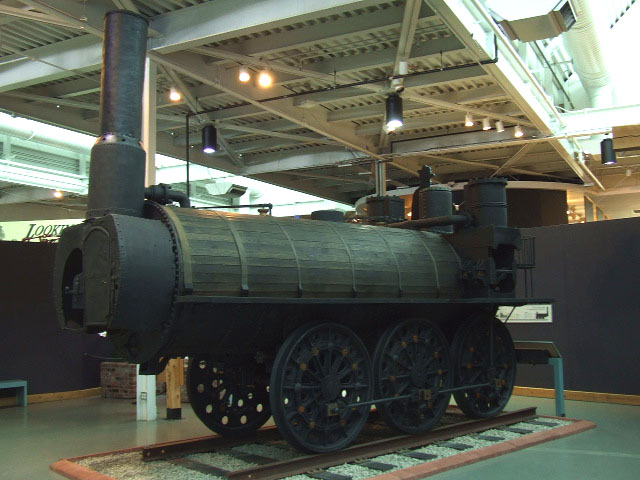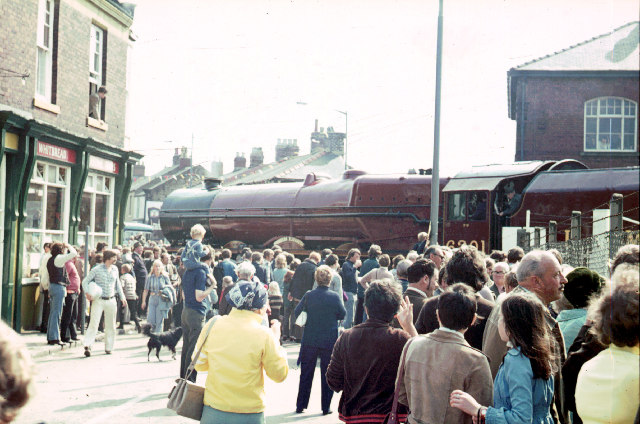|
National Railway Museum
The National Railway Museum is a museum in York forming part of the Science Museum Group. The museum tells the story of rail transport in Britain and its impact on society. It is the home of the national collection of historically significant railway vehicles such as Mallard, Stirling Single, Duchess of Hamilton and a Japanese bullet train. In addition, the National Railway Museum holds a diverse collection of other objects, from a household recipe book used in George Stephenson's house to film showing a " never-stop railway" developed for the British Empire Exhibition. It has won many awards, including the European Museum of the Year Award in 2001. the museum is about to embark on a major site development. As part of the York Central redevelopment which will divert Leeman Road, the National Railway Museum will be building a new entrance building to connect the two separate parts of the museum together. At the same time, the space around the museum will be landscaped to ... [...More Info...] [...Related Items...] OR: [Wikipedia] [Google] [Baidu] |
York
York is a cathedral city with Roman origins, sited at the confluence of the rivers Ouse and Foss in North Yorkshire, England. It is the historic county town of Yorkshire. The city has many historic buildings and other structures, such as a minster, castle, and city walls. It is the largest settlement and the administrative centre of the wider City of York district. The city was founded under the name of Eboracum in 71 AD. It then became the capital of the Roman province of Britannia Inferior, and later of the kingdoms of Deira, Northumbria, and Scandinavian York. In the Middle Ages, it became the northern England ecclesiastical province's centre, and grew as a wool-trading centre. In the 19th century, it became a major railway network hub and confectionery manufacturing centre. During the Second World War, part of the Baedeker Blitz bombed the city; it was less affected by the war than other northern cities, with several historic buildings being gutted and restore ... [...More Info...] [...Related Items...] OR: [Wikipedia] [Google] [Baidu] |
Locomotive Depot
The motive power depot (MPD) or locomotive depot, or traction maintenance depot (TMD), is the place where locomotives are usually housed, repaired and maintained when not being used. They were originally known as "running sheds", "engine sheds" or, for short, just sheds. Facilities are provided for refuelling and replenishing water, lubricating oil and grease and, for steam engines, disposal of the ash. There are often workshops for day to day repairs and maintenance, although locomotive building and major overhauls are usually carried out in the locomotive works. (Note: In American English, the term ''depot'' is used to refer to passenger stations or goods (freight) facilities and not to vehicle maintenance facilities.) German practice The equivalent of such depots in German-speaking countries is the ''Bahnbetriebswerk'' or ''Bw'' which has similar functions, with major repairs and overhauls being carried out at '' Ausbesserungswerke''. The number of these reduced drasti ... [...More Info...] [...Related Items...] OR: [Wikipedia] [Google] [Baidu] |
British Rail Class 31
The British Rail Class 31 diesel locomotives, also known as the Brush Type 2 and previously as Class 30, were built by Brush Traction from 1957-62. They were numbered in two series, D5500-D5699 and D5800-D5862. Construction of the first locomotive was completed in the final week of September 1957, and the handing-over took place on 31 October. The first Class 31 entered service in November 1957, after the launch of the Class 20 locomotive and was one of the Pilot Scheme locomotives ordered by British Railways to replace steam traction. Engines They were originally built with Mirrlees JVS12T (D5500–D5519) and engines and Brush electrical equipment, but the engines were not successful and in 1964 D5677 was fitted with an English Electric 12SVT engine (similar to the 12CSVT used in the Class 37 but without an intercooler) rated at . The trial proved successful, and between 1965 and 1969 the entire class was re-engined. The de-rated engine was used as it was the maximum the e ... [...More Info...] [...Related Items...] OR: [Wikipedia] [Google] [Baidu] |
Timothy Hackworth
Timothy Hackworth (22 December 1786 – 7 July 1850) was an English steam locomotive engineer who lived in Shildon, County Durham, England and was the first locomotive superintendent of the Stockton and Darlington Railway. Youth and early work Timothy Hackworth was born in Wylam in 1786, five years after his fellow railway pioneer George Stephenson had been born in the same village. Hackworth was the eldest son of John Hackworth who occupied the position of foreman blacksmith at Wylam Colliery until his death in 1804; the father had already acquired a considerable reputation as a mechanical worker and boiler maker. At the end of his apprenticeship in 1810 Timothy took over his father's position. Since 1804, the mine owner, Christopher Blackett had been investigating the possibilities of working the mine's short colliery tramroad by steam traction. Blackett set up a four-man working group including himself, William Hedley, the viewer; Timothy Hackworth, the new foreman smith ... [...More Info...] [...Related Items...] OR: [Wikipedia] [Google] [Baidu] |
The Railway Magazine
''The Railway Magazine'' is a monthly British railway magazine, aimed at the railway enthusiast market, that has been published in London since July 1897. it was, for three years running, the railway magazine with the largest circulation in the United Kingdom, having a monthly average sale during 2009 of 34,715 (the figure for 2007 being 34,661). It was published by IPC Media until October 2010, with , and in 2007 won IPC's 'Magazine of the Year' award. Since November 2010, ''The Railway Magazine'' has been published by Mortons of Horncastle. History ''The Railway Magazine'' was launched by Joseph Lawrence and ex-railwayman Frank E. Cornwall of Railway Publishing Ltd, who thought there would be an amateur enthusiast market for some of the material they were then publishing in a railway staff magazine, the ''Railway Herald''. They appointed as its first editor a former auctioneer, George Augustus Nokes (1867–1948), who wrote under the pseudonym "G. A. Sekon". He quickly ... [...More Info...] [...Related Items...] OR: [Wikipedia] [Google] [Baidu] |
Durham County Council
Durham County Council is a local authority administering all significant local government functions in the unitary authority area of County Durham in North East England. The council area covers part of the ceremonial county of County Durham, excluding those parts which now form part of the Borough of Darlington, Borough of Hartlepool and the part of Borough of Stockton-on-Tees north of the River Tees. Between its establishment in 1889 and major local government reforms in England in 1974, the council administered the historic county of Durham Following the 2021 Durham County Council election the council is under no overall control. A Conservative/Liberal Democrat/Independents coalition was formed at the 2021 Annual General Meeting. From 1919 to 2021 the council was under the control of the Labour Party, who held a majority except from 1922 to 1925. At the time of the 2011 census the council served a population of 513,200, which makes it one of the most-populous loc ... [...More Info...] [...Related Items...] OR: [Wikipedia] [Google] [Baidu] |
County Durham
County Durham ( ), officially simply Durham,UK General Acts 1997 c. 23Lieutenancies Act 1997 Schedule 1(3). From legislation.gov.uk, retrieved 6 April 2022. is a ceremonial county in North East England.North East Assembly �About North East England. Retrieved 30 November 2007. The ceremonial county spawned from the historic County Palatine of Durham in 1853. In 1996, the county gained part of the abolished ceremonial county of Cleveland.Lieutenancies Act 1997 . Retrieved 27 October 2014. The county town is the of [...More Info...] [...Related Items...] OR: [Wikipedia] [Google] [Baidu] |
Shildon
Shildon is a town and civil parish in County Durham, in England. The population taken at the 2011 Census was 9,976. The town has the Locomotion Museum, due to it having the first , built in 1825, and locomotive works on the Stockton and Darlington Railway. History The name Shildon comes from the Old English word ''sceld'', This translates as 'shelf shaped hill' or 'shield/refuge'. Another possibility is the Old English word ''syclfe'' meaning 'shelf' and the suffix ''duri'' meaning 'hill'. This refers to the town's location on a limestone escarpment.Shildon County Durham Conservation Area Prepared for Sedgefield Borough Council Conservation Area Character Appraisal December 2008 ''Report No: 0055/1-08'' Report by Archaeo-Environment Ltd The earliest inhabitants of the area were most likely present from the Mesolithic period some 6,000 years ago. Although no evidence of settlement has been found in Shildon itself a small flint tool discovered in the nearby Brusselton a ... [...More Info...] [...Related Items...] OR: [Wikipedia] [Google] [Baidu] |
National Railway Museum Shildon
Locomotion, previously known as Locomotion the National Railway Museum at Shildon, is a railway museum in Shildon, County Durham, England. The museum was renamed in 2017 when it became part of the Science Museum Group. Overview The museum was opened on 22 October 2004 by Prime Minister and local MP Tony Blair. Built at a cost of £11.3 million, it is based on the former "Timothy Hackworth Victorian Railway Museum". The museum is operated in partnership with Durham County Council and was expected to bring 60,000 visitors a year to the small town. However, during its first six months, the museum attracted 94,000 visits. Locomotion was shortlisted as one of the final five contenders in the Gulbenkian Prize, which is the largest arts prize in the United Kingdom. As part of the 2025 plans for the National Railway Museum, a second building will be built to house more of the wider collection. In addition, parts of the original museum including the coal drops will be restored having ... [...More Info...] [...Related Items...] OR: [Wikipedia] [Google] [Baidu] |
York Minster
The Cathedral and Metropolitical Church of Saint Peter in York, commonly known as York Minster, is the cathedral of York, North Yorkshire, England, and is one of the largest of its kind in Northern Europe. The minster is the seat of the Archbishop of York, the third-highest office of the Church of England (after the monarch as Supreme Governor and the Archbishop of Canterbury), and is the mother church for the Diocese of York and the Province of York. It is run by a dean and chapter, under the Dean of York. The title " minster" is attributed to churches established in the Anglo-Saxon period as missionary teaching churches, and serves now as an honorific title; the word ''Metropolitical'' in the formal name refers to the Archbishop of York's role as the Metropolitan bishop of the Province of York. Services in the minster are sometimes regarded as on the High Church or Anglo-Catholic end of the Anglican continuum. The minster was completed in 1472 after several centurie ... [...More Info...] [...Related Items...] OR: [Wikipedia] [Google] [Baidu] |



.jpg)




